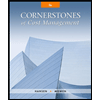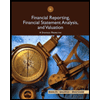
1.
Case Study:
Company E is developing educational software for the primary and secondary school markets. In order to maintain the market place the owner entrusted the
To determine:
Conversion price of bond
1.
Explanation of Solution
Formula to calculate conversion price:
Substitute the value of par value: $1,000 and shares received: 40 shares in the above formula.
Therefore, the conversion price is $25 per share.
2.
To determine:
Convertible’s straight debt value and implied value of convertibility feature.
2.
Explanation of Solution
Formula to calculate straight debt-value:
Substitute the value of Annual interest: $85,par value: $1,000, rate: 10% and number of years are 20 in the above formula.
Calculation of straight debt-value:
Formula to calculate implied value:
Substitute the
Therefore, the straight debt value is $872.30 and implied value of convertibility feature is $127.70.
3.
To determine:
Formula for expected conversion
3.
Explanation of Solution
Formula to calculate conversion value:
Substitute the above equation where CR is the number of shares the bonds can be converted into: 40 shares, P0 is the current stock price: $20, g is the growth rate: 8% and t is time: 0 years in the above formula.
Calculation of conversion value at the end of year 0:
Substitute the above equation where CR is the number of shares the bonds can be converted into: 40 shares, P0 is the current stock price: $20, g is the growth rate: 8% and t is time: 10 years in the above formula.
Calculation of conversion value at the end of year 10:
Therefore, the conversion value at the end of year 0 is $800 and at the end of year 10 is $1,727.14.
4.
To explain:
The meaning of Floor value. Also, Floor value of convertible at the end of year 0 and year 10
4.
Explanation of Solution
The floor value refers to the higher value among the straight-debt value and the conversion value. The conversion value is $800 and the straight debt value is $872.30 at the year 0. So the floor value would be $872.30. at year 10, the conversion value is $1,727 which is higher than the straight debt value. So the floor value is $1,727 at the end of year 10.
5.
To determine:
Expected year when the issue would be called.
5.
Explanation of Solution
Formula to calculate number of years:
Substitute the future value: $1,200,
Calculation of number of years:
Since call must occur on anniversary date, that is why the answer is rounded to 6. So, the bond should be called after 6 years.
6.
To determine:
Expected cost of capital of the convertible and whether this cost is consistent with the riskiness of the issue.
6.
Explanation of Solution
Substitute the value of shares converted: 40, current stock price: $20, rate: 0.08 and n represents number of years in the above formula.
Formula to calculate
Substitute the value of rate with lower rate which is assumed as: 11%, net cash flows: $1,354.50 and n is number of years: 6 in the above formula.
Calculation of NPV:
Substitute the value of rate with higher rate which is assumed as: 12%, net cash flows: $1,354.50 and n: 6 in the above formula.
Formula to calculate
Substitute the values of Lower rate (LR): 11%, higher rate (HR): 12%, NPVLR: $678.726 and NPVHR: $643.168 in the above formula.
Calculation of IRR:
Formula to calculate cost of equity:
Substitute the value of D0: $1, r: 0.08 and P0: $20 in the above formula.
Calculation of cost of equity:
The firm’s convertible bond has risk which is a blend of the cost of debt (10%) and the cost of equity (13.40%), so Cost of capital should fall between the cost of debt and equity. So, the 12.91 percent cost appears reasonable.
Since the cost of capital is between Cost of debt and cost of equity, the costs are consistent with the risk.
7.
To compute:
After tax cost of the bond
7.
Explanation of Solution
Formula to calculate after tax cost:
Substitute the Coupon rate: 8.5%, bond value: $1,000 and tax rate: 0.25 in the above formula.
Calculation of after tax cost:
Therefore, after tax cost of the bond is $63.75.
Want to see more full solutions like this?
Chapter 20 Solutions
Bundle: Financial Management: Theory & Practice, 16th + MindTap, 1 term Printed Access Card
- How do you calculate the payback period of an investment, and what are its limitations as a decision-making tool?arrow_forwardWhat are the main components of a company's capital structure, and how does each affect the company's overall risk and return?arrow_forwardWhat does the internal rate of return (IRR) tell you about a potential investment?arrow_forward
- Explain the difference between systematic risk and unsystematic risk. Which one can be diversified away?arrow_forwardWhat is the formula for calculating the present value of a future cash flow, and why is discounting used in finance?arrow_forwardWhat is the formula for calculating the present value of a future cash flow, and why is discounting used in finance? Explaarrow_forward
- Explain the difference between systematic risk and unsystematic risk. How can an investor reduce unsystematic risk in their portfolio?need help!arrow_forwardExplain the difference between systematic risk and unsystematic risk. How can an investor reduce unsystematic risk in their portfolio?arrow_forwardA firm has a project with an initial investment of $100,000 and cash inflows of $30,000 per year for 5 years. If the firm’s required rate of return is 10%, should the project be accepted based on its net present value (NPV)? Need helparrow_forward
- A firm has a project with an initial investment of $100,000 and cash inflows of $30,000 per year for 5 years. If the firm’s required rate of return is 10%, should the project be accepted based on its net present value (NPV)?arrow_forwardDefine capital structure. What are the main factors that influence a company's decision on how much debt versus equity to use? Exparrow_forwardDefine capital structure. What are the main factors that influence a company's decision on how much debt versus equity to use?arrow_forward
 Intermediate Financial Management (MindTap Course...FinanceISBN:9781337395083Author:Eugene F. Brigham, Phillip R. DavesPublisher:Cengage Learning
Intermediate Financial Management (MindTap Course...FinanceISBN:9781337395083Author:Eugene F. Brigham, Phillip R. DavesPublisher:Cengage Learning
 Cornerstones of Cost Management (Cornerstones Ser...AccountingISBN:9781305970663Author:Don R. Hansen, Maryanne M. MowenPublisher:Cengage Learning
Cornerstones of Cost Management (Cornerstones Ser...AccountingISBN:9781305970663Author:Don R. Hansen, Maryanne M. MowenPublisher:Cengage Learning Financial Reporting, Financial Statement Analysis...FinanceISBN:9781285190907Author:James M. Wahlen, Stephen P. Baginski, Mark BradshawPublisher:Cengage Learning
Financial Reporting, Financial Statement Analysis...FinanceISBN:9781285190907Author:James M. Wahlen, Stephen P. Baginski, Mark BradshawPublisher:Cengage Learning



